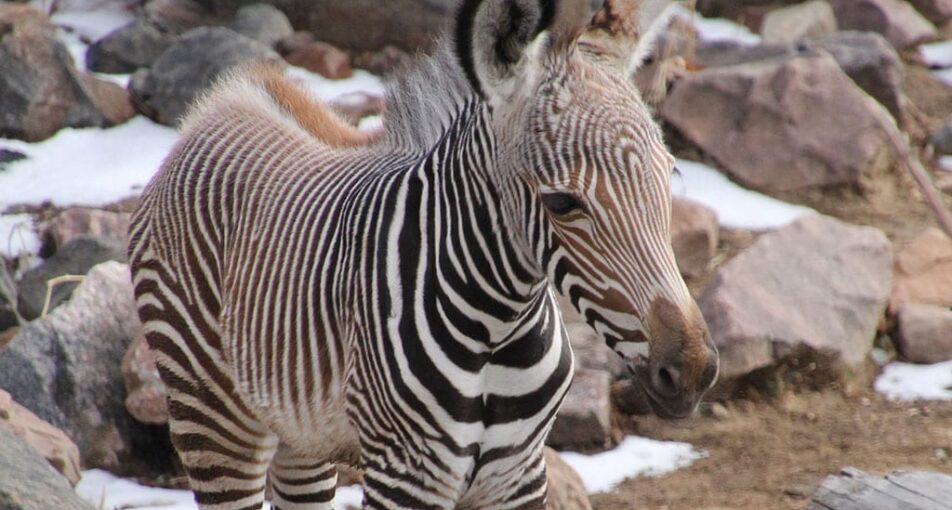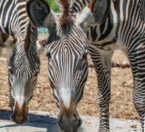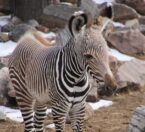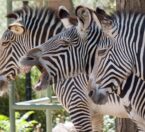Zebras have black skin with white and black stripes in their hair. They are black in the womb. Unlike tigers, their pattern is not replicated on their skin. Their stripes are used to help confuse predators when they stand in a herd – it’s tough to tell where one zebra starts and another ends. Stripes are also helpful when zebras are identifying each other.
Classification
| CLASS: | Mammalia |
| ORDER: | Perissodactyla |
| FAMILY: | Equidae |
| GENUS: | Equus |
| SPECIES: | grevyi |
Habitat & Range
Dry desert regions and open grasslands.
Grevy’s zebra ranges through Kenya and small isolated populations in Ethiopia. They are regionally extinct in Djibouti, Eritrea and Somalia.
Location


Unlike the plentiful plains zebra, the Grevy’s zebra is endangered. In 1977 there were approximately 15,200 Grevy’s zebra. Today there are fewer than 2000 remaining. They are considered extinct in Somalia and are now listed as endangered in CITES I. Grevy’s zebra are being crowded out of their grazing habitat by domestic livestock and are threatened by poorly managed tourism but they are legally protected in Ethiopia and benefit from a hunting ban in Kenya.
Adaptations
- Eyes on the Side
- Zebra have large eyes located high up on their head. Eye placement allows them to scan their surroundings for predators while they continue grazing. The only blind spot is directly behind them. Individual zebra within a group often face different directions so they can observe in all directions providing protection for the entire group.
- Chomp, Chomp!
- Grevy’s zebra have long muzzles with 40-42 constantly growing teeth that are used to crop and grind the coarse vegetation they eat. Their eyes are located far up on their head to make room for the roots of their large cheek teeth!
- I Know You
- Zebra communicate in several different ways. The stripes help them recognize others of their species. They also make loud donkey-like braying calls.
- The Skinny on Stripes
- All zebra are white with black stripes not black with white stripes! The stripes of the Grevy’s zebra are very narrow compared to other zebra species. Their stripes continue all the way down their legs to the hooves, and the underbelly is white. The pattern of stripes on each zebra is unique and can be used to identify individual animals. The stripes also function as a form of camouflage breaking up the outline of the zebra and confusing predators.
Physical Description
- Males weigh between 836-990 pounds (380-450 kg), and females weigh between 770-880 pounds (350-400 kg).
- Stand about 63 inches (160 cm) at the shoulder.
- Grevy’s zebra have short white fur with narrow black stripes and a white underbelly.
- They have a tall, erect mane along the neck and back.
- They have large rounded ears and eyes high up on the side of the head.
Diet
What Does It Eat?
In the wild:
Grasses and other plants.
At the zoo:
Hay, alfalfa, grain.
What Eats It?
Lions, wild dogs, leopards prey on Grevy’s zebra. The zebra has also been used by native peoples for food and its striking hide.

Social Organization
Unlike other zebra species, Grevy’s zebra do not form permanent herds. The only strong social relationship is between females and their offspring. Most Grevy’s zebra live in unstable groups of 20-30 individuals consisting of mares with foals, other females and bachelor males. The groups may change from day to day. Grevy’s zebra stallions set up large territories and mate with any females that wander through the territory. Males will tolerate other males within the territory as long as they do not interfere with their activities.
Life Cycle
Both males and females are sexually mature by three to four years of age although males are not usually dominant enough to mate until they are about six years old. Mating can occur throughout the year. After a 13-month gestation, a single foal is born weighing 80-125 pounds (36-56 kg). Newborn foals have dark brown stripes and fuzzy coats; by one year, foals are less fuzzy and their stripes turn black. Foals can stand within 15 minutes, walk within a half hour and run short distances less than an hour after birth. In the first few hours, foals imprint on their mother and will follow her for protection. They nurse for up to eight months but begin to nibble on grasses within a week. Although they are relatively independent by nine months, they will stay with mom up to three years. Grevy’s zebra live 18-20 years in the wild, but up to 30 years in captivity.
















